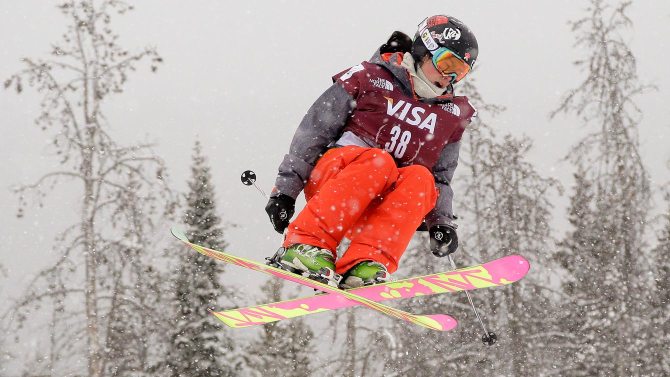
Canadian slopestyle skier and Olympic medal contender Yuki Tsubota on a better day.
Fails and falls: How do athletes recover?
You know Canadians felt for short track speedskaters Charles and François Hamelin last week. Luck for the Brothers Hamelin seemed to run from bad to worse after François crashed when his skate caught an edge during the semifinal men’s short track 5,000-metre relay, disqualifying the team for the Olympic final. The team won gold in the Vancouver 2010 Winter Olympics and was expected to do very well. Instead, they came in last. Two more crashes ended the dream of becoming ultimate Canadian Olympian for older brother Charles. He was contending for medals in both the 500 and 1,000 short track races when he fell; understandably he was very upset.
Honest, raw emotion. RT @Beezersun: Charles Hamelin on his thoughts after his fall: “I wanted to destroy everything.” #shorttrack
— Arash Madani (@ArashMadani) February 18, 2014
And you could almost hear the collective wince when Canadian slopestyle skier and Olympic medal contender Yuki Tsubota took that horrific tumble last Tuesday during her second run in the finals. (Apparently, she suffered a jaw injury but no other injuries.) Her teammates, Dara Howell and Kim Lamarre, went on to take the gold and bronze medals at the same event.
https://vine.co/v/MWtpn9q90Uj/embed
UM Today spoke with assistant professor in the Faculty of Kinesiology and Recreation Management, Leisha Strachan, about how athletes recover after they’ve taken a fall or made an error. Strachan’s research focuses on positive youth development, and she’s also competed at national and world levels as a competitive baton twirler.
She and her colleague, Adrienne Leslie-Toogood at the Canadian Sport Centre Manitoba, also do research on dealing with failure — from the perspective of young athletes as well as coaches or parents who support those athletes.
“We talk about building the five C’s: competence, confidence, connection, character and caring,” she explains.
“Very generally, we try to get kids feeling competent in their sport and feeling confidence in themselves through building skills, feeling some connection with their peers, coaches or other adults, working on building character, especially characteristics such as resilience and determination, and showing caring towards others that they share their sport experience with.”
Strachan laughs that the Olympics are also the perfect coaching tool. “There are so many stories and they interview so many athletes who can teach us important lessons.”
Here are a few she shared with UM Today.
Emphasize competence and confidence
With something like the very dramatic crashes and things you see at the Olympics, she says, “it’s about emphasizing competence — given that these are elite athletes working at a very high level — this can help them to continue on. The key is trying to remember that it’s an isolated incident.”
Use positive self-talk
Remind yourself that you can do it and keep using positive self-talk, Strachan advises.
“You’ve gotten this far, so you have the skills. In the hundreds of times that they practice and repeat the same thing, a fall is something very dramatic but doesn’t necessarily happen that often.”
Use positive imagery
“The research points to imagery being used in a variety of ways. It can be used to imagine — to foresee and rehearse — being successful in terms of skills and strategies going into a performance. It can also being used to manage anxiety and increase confidence.
She says it’s important to make the imagery as vivid and realistic as possible, using all the senses, from sight to smell to feeling.
“Seeing yourself being successful in adverse situations can also be helpful. Use imagery to create — or recreate — how you might feel at that time and how you can overcome that feeling.”
Be consistent
The positive self-talk and imagery you use needs to be consistent from event to event, says Strachan, whether it’s a small or big event.
“Your preparation, your planning, what you are saying in your head to yourself, it all needs to be consistent.”
Consistency helps to provide an inner template of sorts.
Find your own inner recipe
“It’s about finding your own inner recipe,” Strachan notes. She likes to use baking as a model, because it’s quite technical: recipes tell you exactly what to put in so that you get the best result.
“For every athlete it’s different. Some gravitate towards imagery and that becomes a really big part of their performance. Some might gravitate towards using music to help them with anxiety, staying calm and focused. It takes time to find out what that perfect recipe is.
“Then write it down and be consistent. That’s very important. It’s the key of sport: You find out what works and be consistent.”
Focus on process rather than pressure
“Often times, it’s the pressure we put on ourselves that makes things difficult,” says Strachan.
“It’s important that we’re thinking not about the magnitude of the event but the steps we need to take. Focusing on one thing at a time rather than what’s around you. Thinking about the next step — this will take me to this part, and that will take me to the next…. In the end all these little words and sentences will make a paragraph, and a story.”
Remember the parts don’t necessarily devastate the whole
One mistake may not wreck your chances. “In my sport of baton, for example,” she says, “similar to figure skating, you can have one or two drops and still win. There are so many things that are left and so many other tricks you can do; in spite of an error, there are so many things that have been accomplished.”
Keep calm and carry on
Strachan says that by thinking about the parts rather than the pressure of the whole, one can recover after a fall. “It’s not something you can think about in the moment — though you might do so after it’s all over. In the moment you just want to get back up and continue.”
Prepare for recovery in practice
Strachan says she learned this one from Kurt Browning. “It seems easy but it’s important: Practice what you’ll perform.
“Some athletes make a mistake and want to start over. Coming up from a fall or a failure if that happens — those are the things you have to practice recovery from.
“Even after you fail or fall, when you get to the end, you realize, ‘Okay, that wasn’t so bad. I was able to do it and learn from it and move on’ — instead of ‘That wasn’t perfect, I need to start over.'”
It takes time
Youth in particular, because they don’t have as much experience, can experience failure as traumatic, she says. It takes time to understand the positive side of it.
Remember there’s value in failure
“There’s a lot of value that can come from failure as an experience,” says Strachan. These are the lessons that youth can learn both from their own failures and from the failures of elite athletes.
“After the performance is over, you can reflect on it and think about how not to have it happen again. It’s often in recovery that you can learn the most about yourself. If you don’t push through it, you lose those lessons.”
In sport as in life
“There’s always a lesson to be learned. Sport can be analogous to life, a tool to show that there are always lessons to be learned.
In the end that’s all that matters — that’s what’s going to carry you through, in sport and in life. We’re competitive and we can lose sight of that.
“Lessons learned, for me as a coach, are sometimes more important than the win.”







